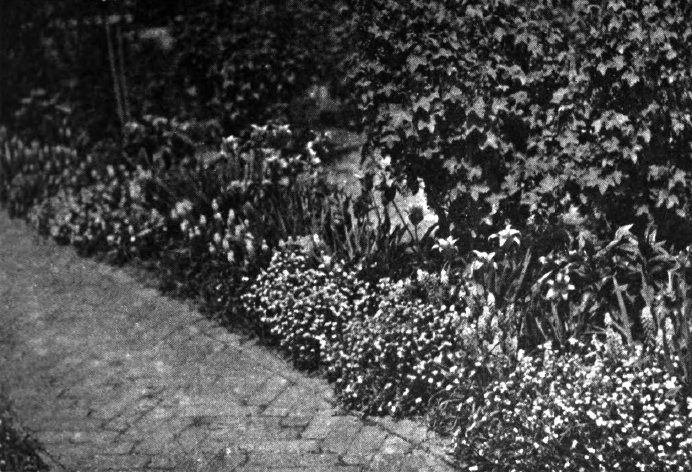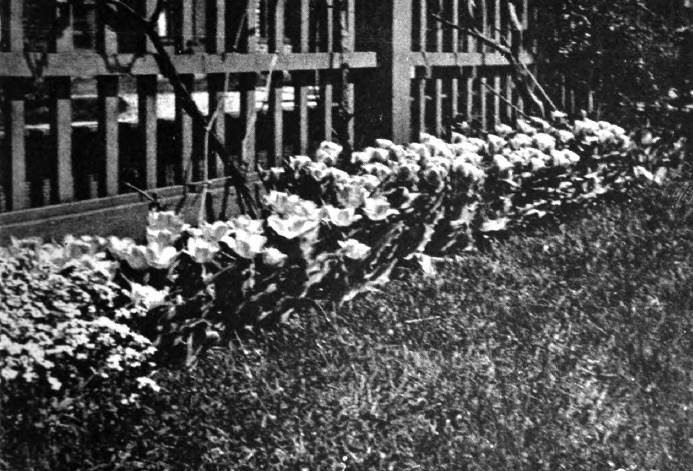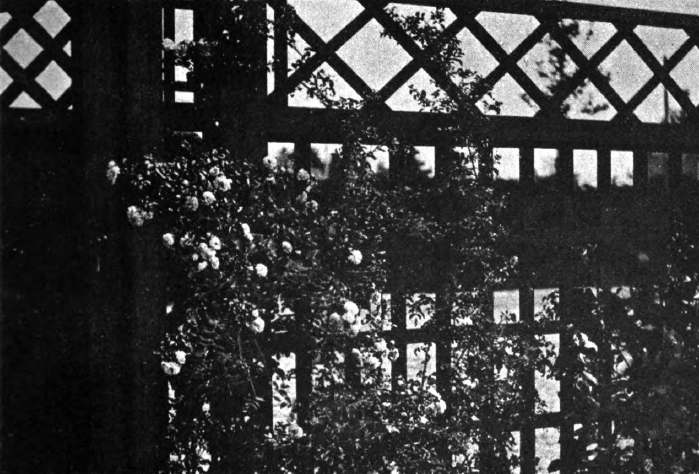| Web
and Book design,
Copyright, Kellscraft Studio 1999-2016 (Return to Web Text-ures) |
 (HOME)
|
|
"Give
me a tree, a well, a hive,
And I can save my soul alive." — "Thanksgiving," KATHARINE TYNAN. SUCCESSION CROPS A very rough and hard
bank of nearly
solid clay with a south exposure has for some years been planted to
narcissus
Emperor, Cynosure, and one or two other rather later varieties.
Striking boldly
along among these, while in full bloom, grows an irregular line,
thickening and
thinning in places, of tulip Vermilion Brilliant, absolutely described
by its
name. As the flowers of these scarlet and yellow bulbs commence to
fade, the ground
below them begins to green with little leaves of calendulas Orange King
and
Sulphur Queen, as well as of the fine double white poppy White Swan.
These
practically cover the dying bulb leaves in a few weeks and produce a
succession
of charming bloom beginning rather early in the summer. A few zinnias
do well
among them, the medium tall varieties grown only from seed labelled
"Flesh-color." For my purposes this zinnia color is always the best.
It generally produces flowers varying from flesh-pink to pale or faded
yellow,
colors which in all their range look so well with yellow or warm pink
flowers
that many unique and lovely combinations are obtained by their free
use. Beware
of the zinnia seed marked "Rose," and of all mixtures of this seed.
The seed rarely comes true to color, and its bad colors are so
hideously wrong
with most other flowers that they are a very real menace to the
beginner in
what we might call picture-gardening. Iceland poppies, thickly
planted
among the narcissi and tulips, would bring a crop of charming silken
blooms
well held above the foliage already on that bank, and coming between
the
earlier and later flower crops. The little walk of dark
brick shown
in the first illustration is bordered in very early spring by blue
grape
hyacinths (Muscari botryoides),
followed closely by the fine forget-me-not Myoaotis
dissitiflora in mounds and sprays. Among these are quantities of
the
cream-white daffodil (Narcissus cernuus).
Alternating with the plants of early forget-me-not are many more of
Sutton's
Perfection and Sutton's Royal Blue, which come into bloom as the
earliest fade;
these grow very tall and form a foreground of perfect loveliness for
the tall Tulipa retroflexa, which rises
irregularly back of the small sky-blue flowers below, completing a
combination
of cream color and light blue charmingly delicate and effective.
Following the
two blue and cream-white crops of flowers bordering this walk,
dark-pink
phloxes bloom in early August, three successive periods of gayety being
thus
assured to the little pathway. A continuation of this
walk, running
toward a wooden gateway in a trellised screen, may boast also of three
successive flower-appearances of different kinds. Back of the brick
edging
bordering the gravel are planted alternating groups of myosotis
Sutton's Royal
Blue, hardy dianthus Her Majesty, and early and late hardy asters, the
two
mentioned in another chapter, Coombe Fishacre and Pulcherrima. First to
enliven
the borders with color is the myosotis, a peculiarly pretty effect
occurring in
the leading up, at either end of the walk, of the irregular edge-groups
of pale
blue to low masses of the old-fashioned Harison's
Yellow and Persian Yellow
rose. Late forget-me-not is never
lovelier than when used in connection with this rose. The combination
reminds
me of the delicate colors of the flower-boxes below each window of
Paquin's
great establishment in the Rue de la Paix, as it may be seen every May.
Following the myosotis and yellow roses come masses of the scented
white pinks,
while by this time the hardy asters have developed into handsome
dark-green
groups of leaves and give all through the summer a rich green
contrasting well
with the gray mounds of dianthus foliage, and finally, in September,
rising
suddenly into sprays of tall, fine lavender bloom. No succession crop of
spring and
early summer that I have happened upon seems to work better than that
of tulip
Yellow Rose planted in small spaces between common and named varieties
of
Oriental Poppy. The tulip, in itself of gorgeous beauty, very rich
yellow and
extremely double, absolutely lacks backbone, and the first heavy shower
brings
its widely opened flowers to earth to be bespattered with mud. The
leaves of
the poppy, upright and hairy, form a capital support for the
misbehaving stem
of Yellow Rose, and the poppies, having thus lent the tulips aid in
time of
need, go a step farther and cover their drying foliage with a handsome
acanthus-like screen of green surmounted by the noble scarlet and
salmon blooms
of early June. This is a very simple, practical, and safe experiment in
succession crops, and is heartily commended. Following these poppies
comes the
bloom of a few plants of campanula Die Fee, and I am trying this year
the
experiment of Campanula pyramidalis in
blues and whites thickly planted among the poppies, for late summer
bloom when
the poppy leaves shall have vanished. This is a large demand to make
upon the
earth in a small space, but, with encouragement by means of several
top-dressings of well-rotted manure, I hope to accomplish this crop
succession
satisfactorily. Among the yellow columbines (Aquilegia
chrysantha) I generally tuck quantities of white or
purple stocks, those known as Sutton's Perfection. The aquilegia is cut
close
to the ground as soon as its seed-pods take the place of flowers; and
the
stocks are then beginning their long period of bloom. Canterbury bells
are
usually the centres of colonies of annual asters (my great favorites
are the
single Aster Sinensis, in chosen
colors — not to be had in every seed-list, by the way), and of groups
of
gladiolus bulbs so arranged as to hide the vacancy left when the
Canterbury
bells must be lifted from the ground after blooming. In four places in the
garden where
rather low-growing things are desired, are alternate groups of a
handsome,
dark, velvety-red sweet-william — the seed of which was given me by
Miss
Jekyll, who described this as the color of the sweet-william of the old
English
cottage garden — and well-grown plants of Stokesia
cyanea. As soon as the fine heads of sweet-william begin to crisp
and dry,
the beautiful lavender-blue flowers of the Stokesia take up the
wondrous tale,
and a veil of delicate blue is drawn over the spots which a few days
since ran
red with a riot of dark loveliness. Among larkspurs I plant Salvia patens, which to look tidy when
blooming must be carefully staked while the stems are pliable and
tender.
Second crops of delphinium bloom seem to me a mistake — I believe the
vitality
of the plant is somewhat impaired and the color of the flowers is
seldom as
clear and fine as in the first crop. Green leaves in plenty should be
left, of
course: the lower part of Salvia patens is
not attractive and its pale-blue flowers have added beauty rising from
the
fresh delphinium foliage. The plan of planting the
everlasting
pea (Lathyrus latifolius, var. The
Pearl) among delphiniums, to follow their
bloom by clouds of white flowers, is recommended by an English
authority. To
continue the blue of tall delphinium, the very best succession crop is
that of Delphinium Chinese or grandiflorum,
the lower branching one
with the cut leaf ; a fine hardy perennial in exquisite shades of pale
and deep
blue, whose flowers are at their very best immediately after the spikes
of
their blue sisters have gone into retirement. The fine new Dropmore
variety of Anchusa Italica is exceedingly good
placed near the vigorous green spikes of the leaves of the white false
dragonhead
(Physostegia Virginica, var. alba):
when the latter is low, the
great anchusa leaves nearly cover it; and after the crop of brilliant
blue
flowers is exhausted, and the robust plants are cut back, the
physostegia
raises its tall white spikes of bloom a few weeks later, brightening an
otherwise dull spot. Platycodons, both blue
and white,
are capital to dwell among and succeed Canterbury bells; the
platycodons to be
followed again in their turn by the later-blooming Campanula
pyramidalis. Will some kind
garden-lover make me
his debtor by suggesting a good neighbor and successor to the hardy
phlox? This
has been a problem in a locality where frost is due in early September,
and
some of the tenderer things, such as cosmos, are really nothing but a
risk. If
one could raze one's phloxes to the ground once they had finished their
best
bloom, the case might be different. But the French growers now advise
(according to interesting cultural instructions for phlox-growing
issued by one
specialist) the retention of all flower stalks during winter! This
makes necessary
an immense amount of work in the way of cutting, toward early
September, in
order that the phloxes may keep some decent appearance as shrublike
plants of
green. To follow the bloom of Iris Gertnanica (of which I find two
varieties planted together, Mrs. Horace Darwin and Gloire de Hillegom,
to give
a charming succession crop of flowers with a change of hue as well), I
have
already recommended the planting of gladiolus. Lilium
candidum growing back of iris leaves is also effective, and,
by carefully considered planting, gladiolus forms a between-crop of no
little
value. Of succession crops to
follow each
other in places apart, it is hardly worth while to speak. This is an
easy
matter to arrange; the fading of color before one shrubbery group
acting as a
signal to another place to brighten. Munstead primroses (cut, page 46)
are
scarcely out of bloom when tulip Cottage Maid and arabis are in beauty,
as in
cut on page 41, in an unused spot under grapes, and these are quickly
followed
by rambler roses (cut, page 48), peonies, and Canterbury bells in the
garden
proper (cut, page 48). Bordering on the turf edges of a walk in a
kitchen
garden three succession crops of flowers have been obtained by the use
of these
three plantings. Roses stand a foot back from the grass. Between them
and the
turf long, irregular masses of Tulipa Gesrwriana,
var. rosea, bloom rich rose-red in May. The roses
follow in June; and
Beauty of Oxford verbena covers the dying tulip leaves with clusters of
wonderful pink bloom which lasts well into the autumn. I have sometimes thought
that a
white garden would be a simple matter to arrange, and that, under
certain very
green and fresh conditions and with plenty of rich shadow to give its
tones
variety, it should not be monotonous. The procession of white flowers
is so
remarkable, beginning, say, with the snowdrop, bloodroot, sweet white
violet,
and the arabis in its single and double forms, followed quickly by Iberia Gibraltarica and Phlox subulata,
white violas — all these
for the low early flowers — and followed by larger, taller, and more
massive
blooms, from peonies on to Canterbury bells, thence to lilies, white
hollyhocks, gypsophilas, Pearl achillea, and white phloxes. Dozens of
flower
names occur at the mere thought. It seems as though every flower must
have its
white representative. Whether an all-white garden would be truly
agreeable or
no, I cannot say, but I do hold that sufficient white is not used in
our
gardens — that a certain brilliancy in sunlight is lost by the absence
of
masses of white flowers, succession crops of which it is so easy to
obtain and
maintain. With the free use of white flowers, there is sure to be a
fresh
proclamation of beauty, too, at twilight and under the moon — arguments
which
must appeal to the amateur gardener of poetic taste. 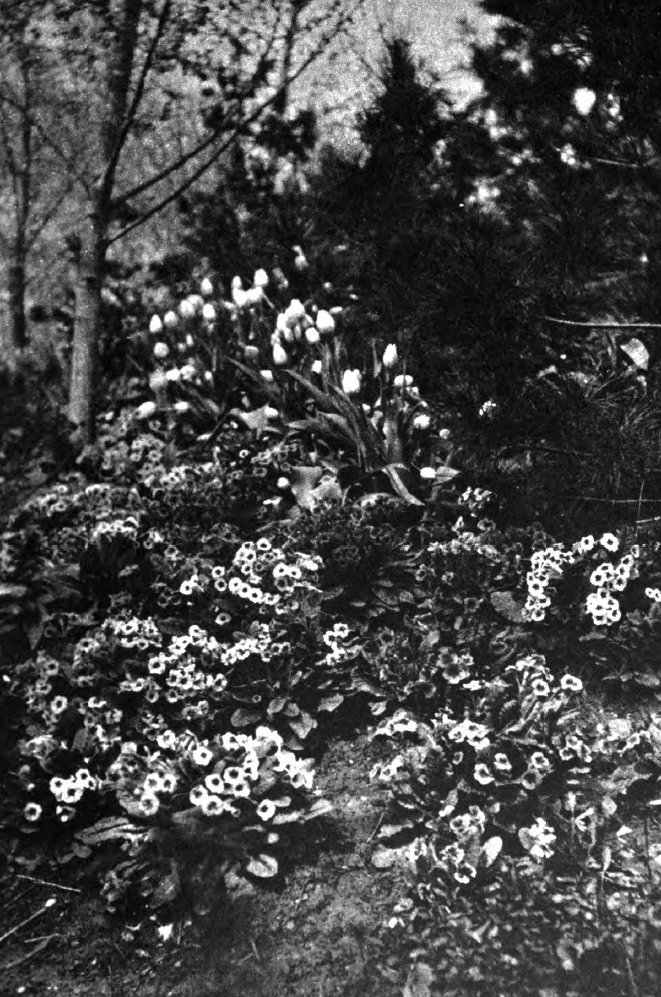 MUNSTEAD PRIMROSE AND TULIP WHITE SWAN ON SLOPE BELOW POPLAR AND PINE 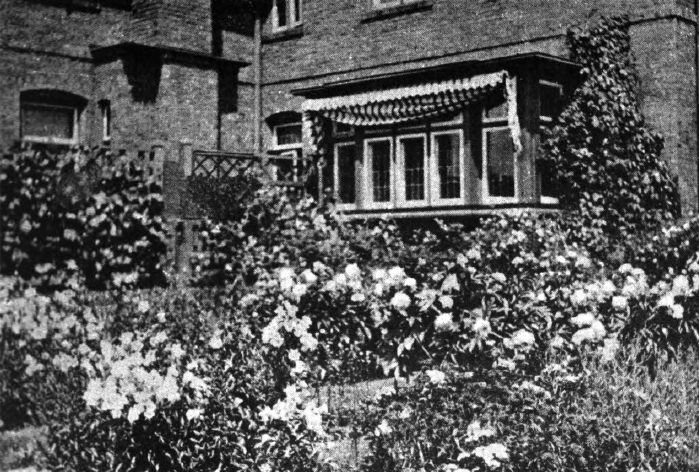 PEONIES AND CANTERBURY BELLS
|
